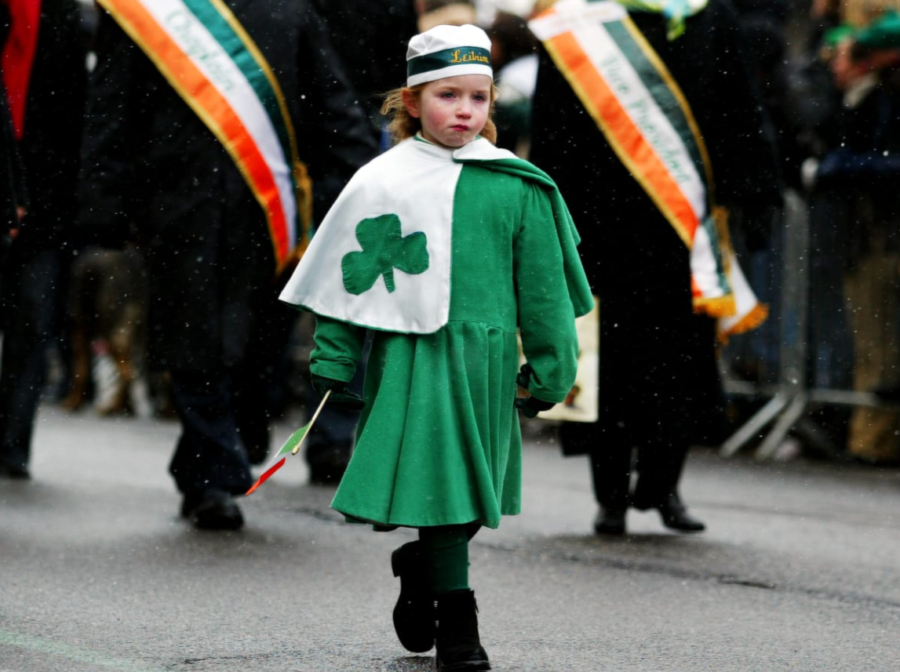Why do we celebrate St. Patrick’s Day?
A picture of a modern replication of the original St Patrick’s day attire. Irish wardrobe typically accompanies this cultural commemoration – ranging from kilts to Celtic dresses.
March 14, 2022
St. Patrick’s Day is right around the corner, and Irish-Americans and non-Irish-Americans alike are preparing for the time-honored holiday. Millions of proud Irishman and women around the United States, and throughout the world for that matter, long await the middle of March for their day of celebration. In fact, according to Insider, a popular American journalism site, a projected $6.16 billion will be spent in the name of St. Patrick (Insider).
When one thinks of St. Patrick’s day, images of leprechauns, shamrocks, and pots of gold come to mind. Personally, the most cultural element of my celebration is my annual purchase of a Shamrock Shake from McDonald’s, a seasonal treat that commemorates the holiday with a minty green splash of celebration.
My cultural celebration, or lack thereof, fairly represents the American general public. Americans are more than willing to put all aside to celebrate a nation as noble as Ireland; however, the majority of those who celebrate know little to nothing about the Emerald Isle. In fact, most do not even know the story of St. Patrick himself, or how his holiday came to be. It’s a fairly unknown story; nevertheless, the tale of St. Patrick and his flourish to fame is an all but forgettable journey of laughter, love, sacrifice, and devotion that all can learn from.
St. Patrick was born in the Fifth Century, A.D., and he lived in Roman Britain for the first 16 years of his life. Soon after his 16th birthday, his life took a turn for the worse, and he was brought to Ireland to work as a slave. Nevertheless, he spent years praying for a way out and asking God for a solution, and six years after his capture, he was able to escape slavery n Ireland, and return to Roman Britain. With his newfound freedom, St Patrick bravely decided to return to Ireland to spread Catholicism (history.com)
St. Patrick was a devout Catholic and lived his life as a dedicated missionary of his cherished faith. He was eventually ordained into the Catholic church as a bishop, and he received mass popularity for his creative sermons. His most famous sermon used a metaphor to describe the Catholic church’s view of the holy trinity of God – the Father, the Son, and the Holy Spirit. For this analogy, he referenced the widespread Irish plant, the three-leaf-clover (time.com). After a lifetime of dedication to spreading Catholicism, St. Patrick died on March 17, 461 A.D.
In the centuries following his death, St. Patrick’s death day began to be celebrated in small quantities throughout Ireland. At about 10 A.DHis celebration became recognized as a Catholic feast day, and it has been celebrated in Ireland since that fateful year. In the United States, hints of the Irish celebration can be traced back to the eighteenth century, where Irish soldiers in the New England colonies historically began hosting St. Patrick’s Day celebrations in the novel United States (gbp.com)
A culmination of these celebrations occurred in 1848, where an influx of Irish immigrants added flame to the fire of American St. Patrick’s day celebration. Several New York Irish Aid groups decided to celebrate their beloved holiday as one, and united their parades to form one official New York St. Patrick’s day parade.
St Patrick’s Day marks an important indicator of American cultural diversity. The Irish were among the first groups to emigrate to the United States, and despite initial persecution, have grown to become an integral part of American identity and culture. Furthermore, St. Patrick’s Day itself has grown to become a global symbol of Irish culture and Irish-American culture, celebrated by hundreds of millions around the world.
As an Irish-Catholic American citizen, I feel compelled to add this new wave of knowledge to my St. Patrick’s Day celebrations. I feel motivated to share the story of St. Patrick and the path that led him to global recognition. Nicole Philips (12) feels immensely excited to celebrate the date. “After hearing about what St. Patrick actually was and what he did” she lamented, “I am so much more excited to celebrate the holiday.”






















